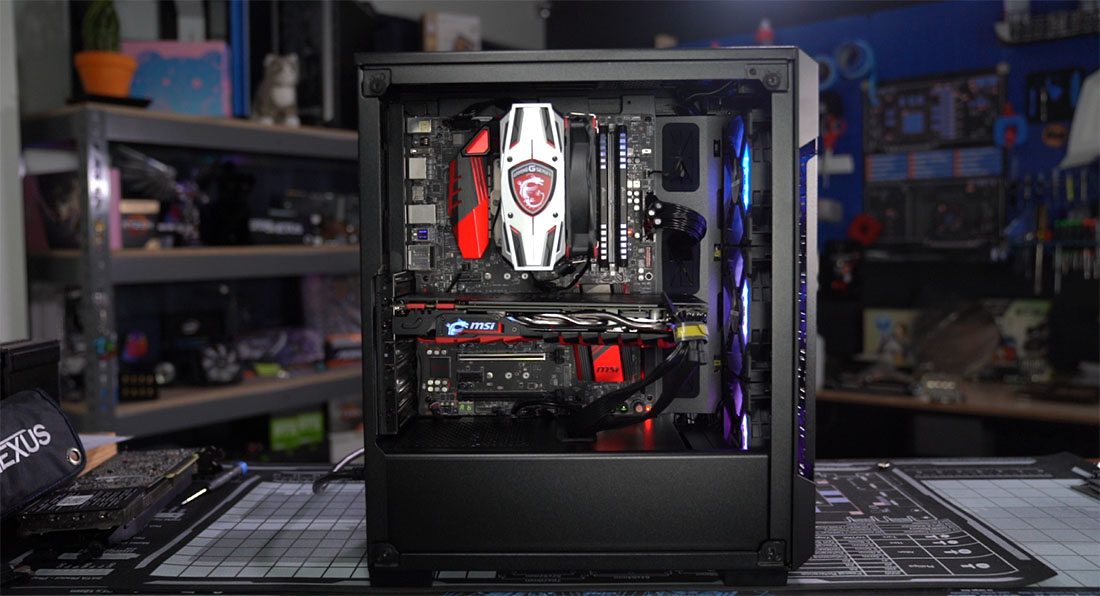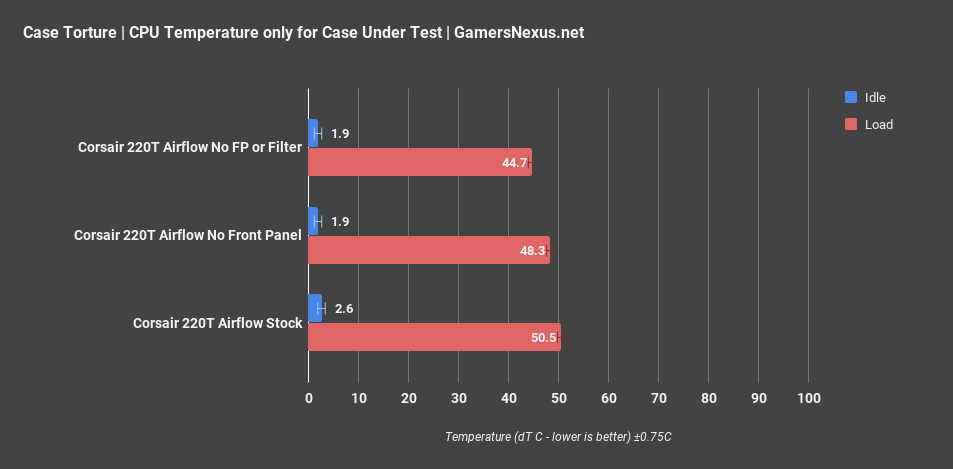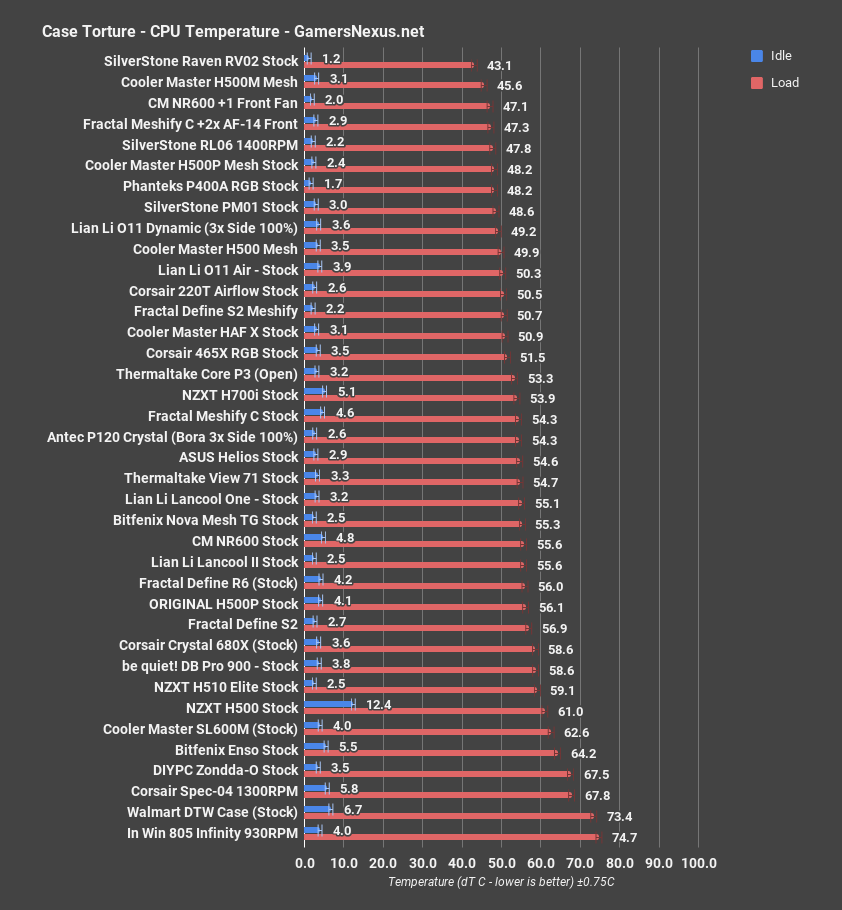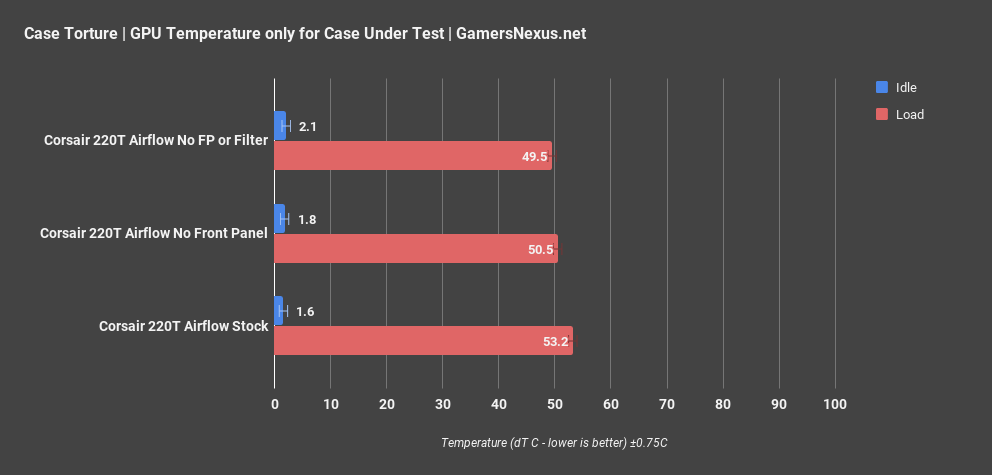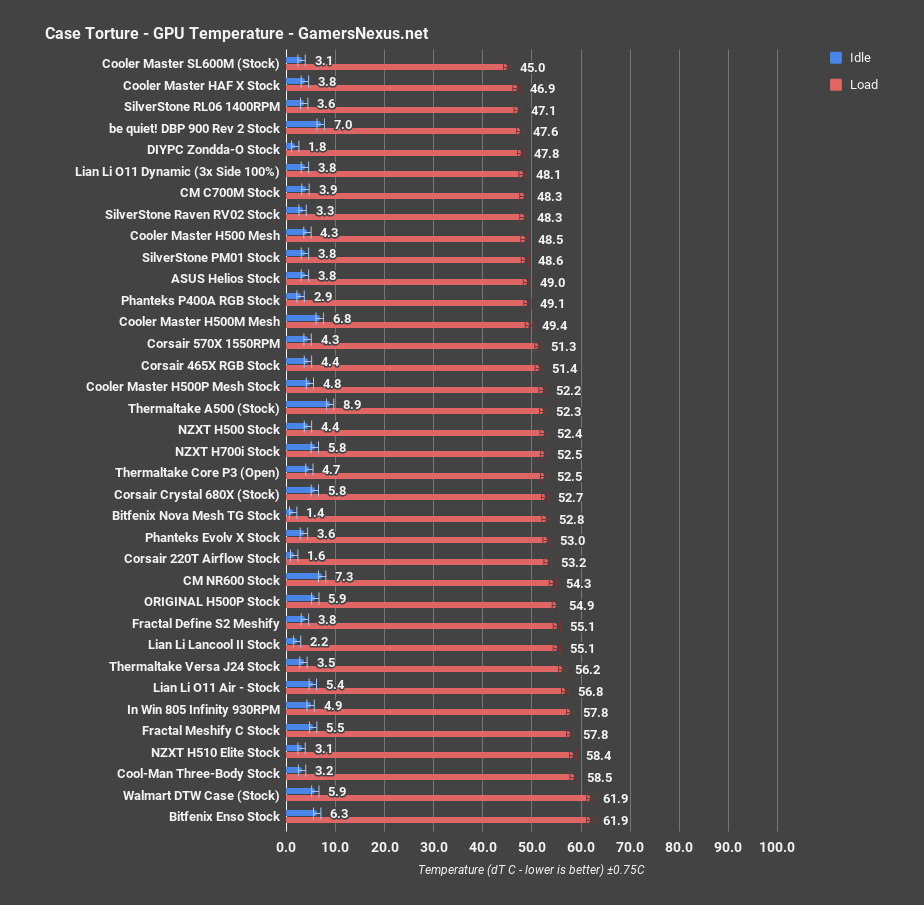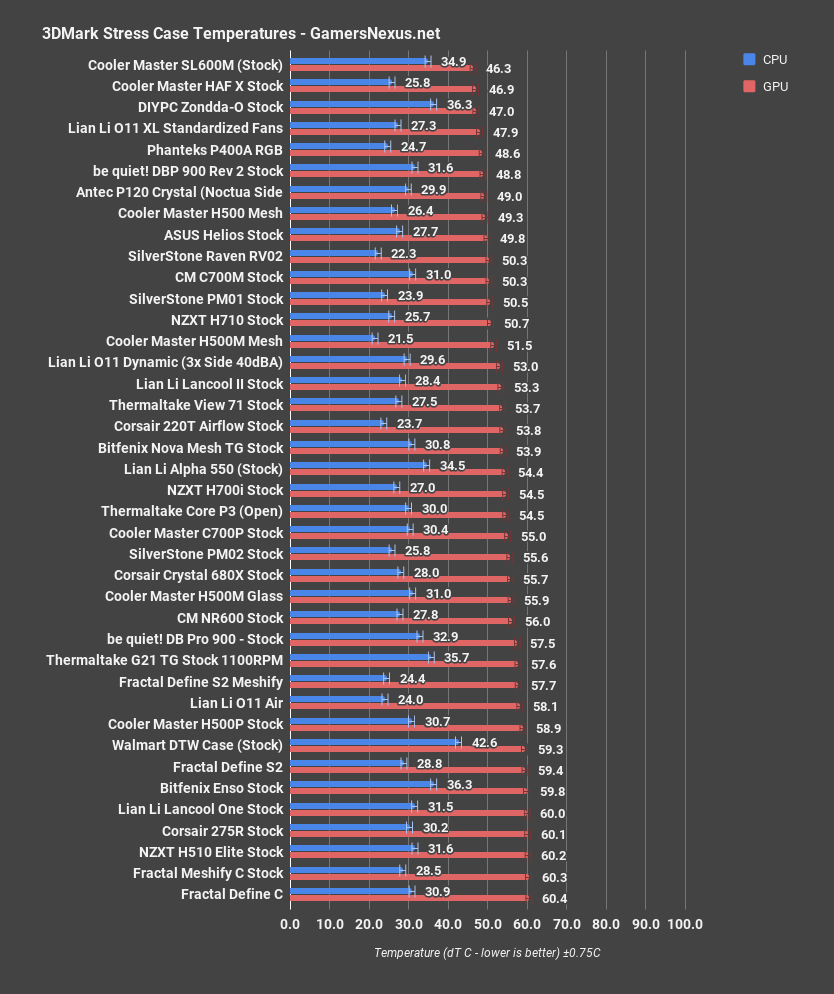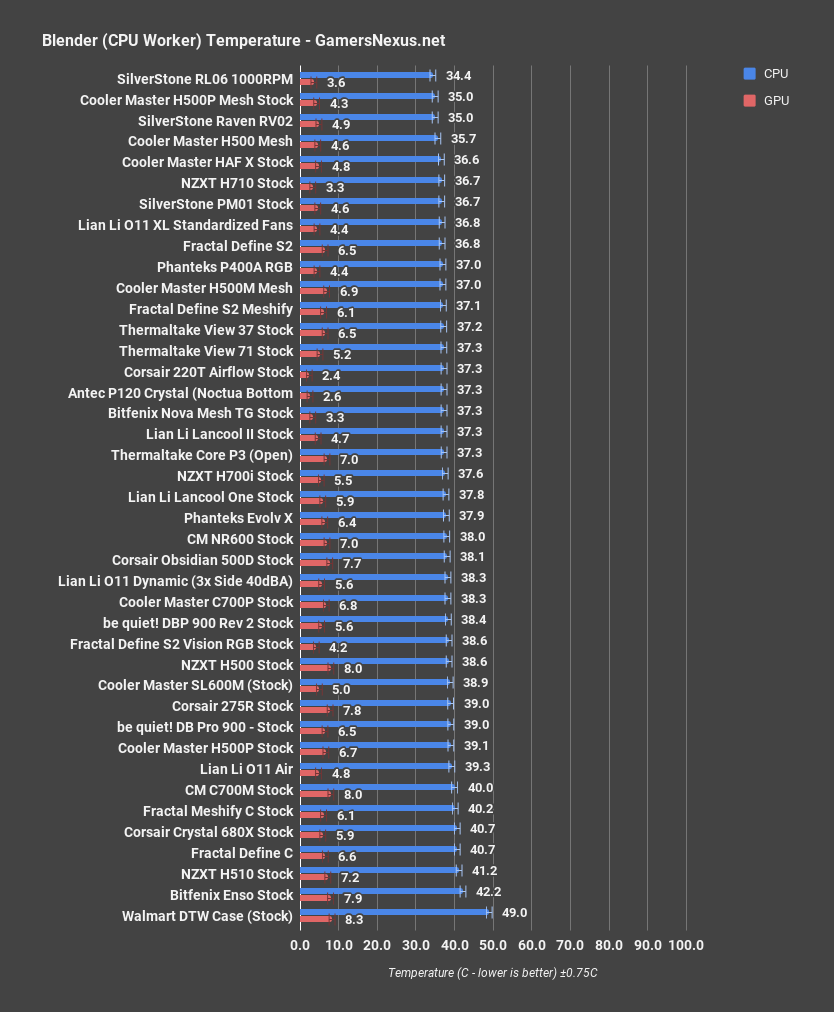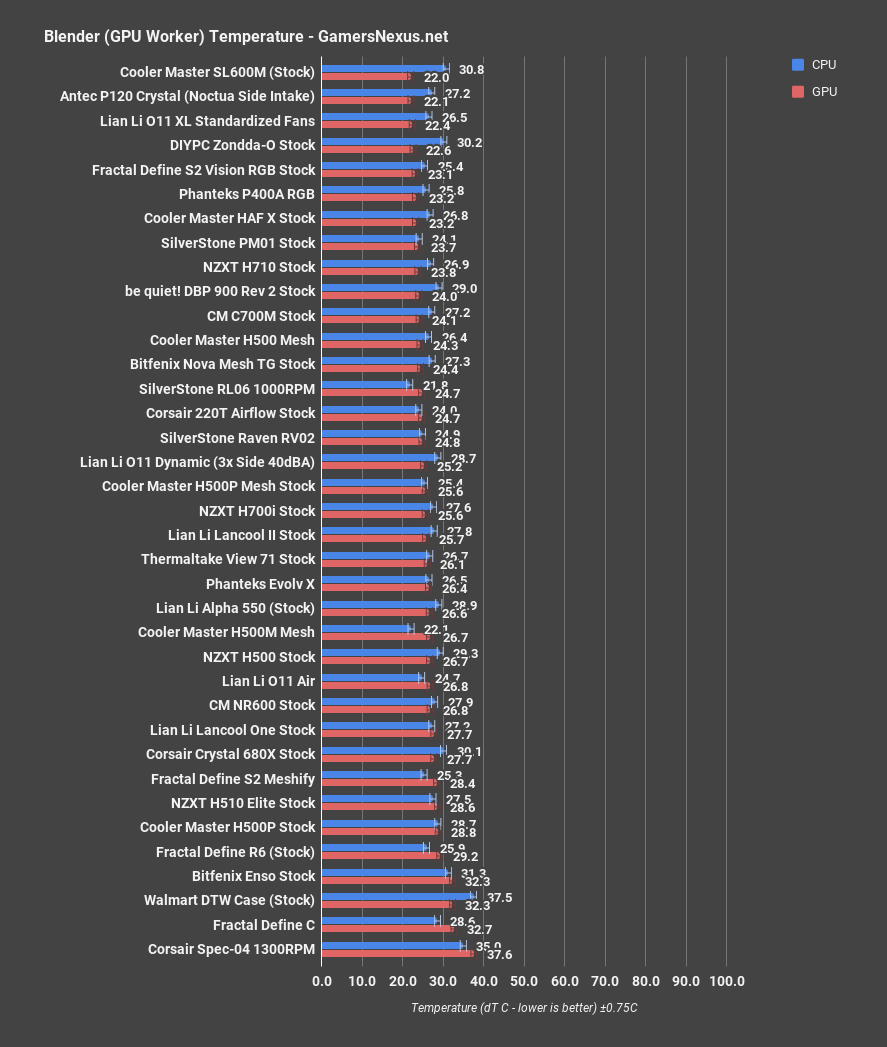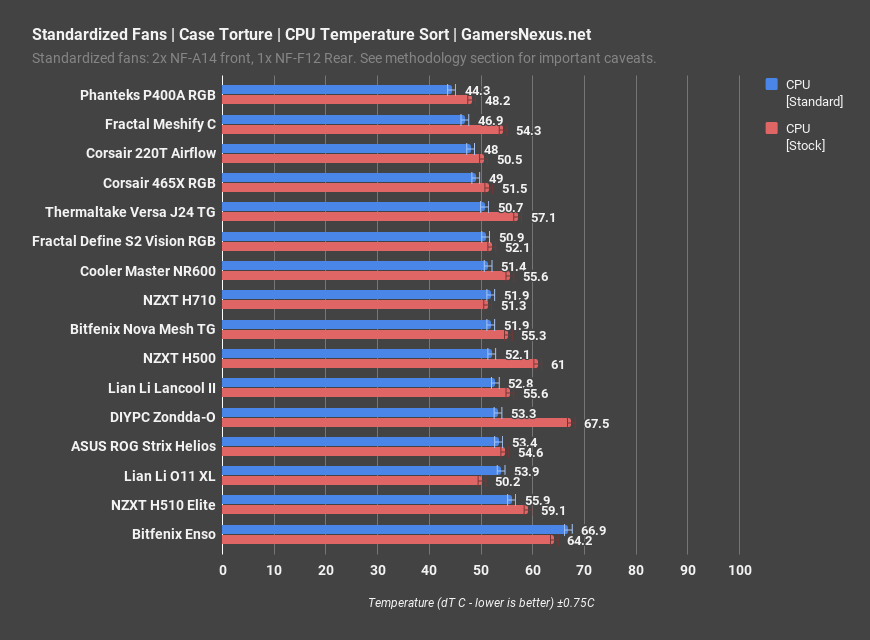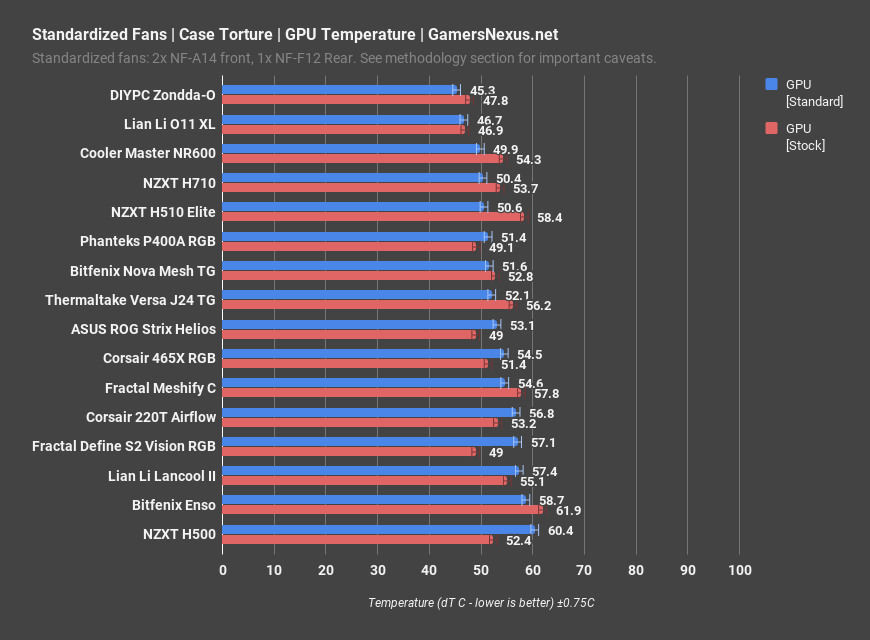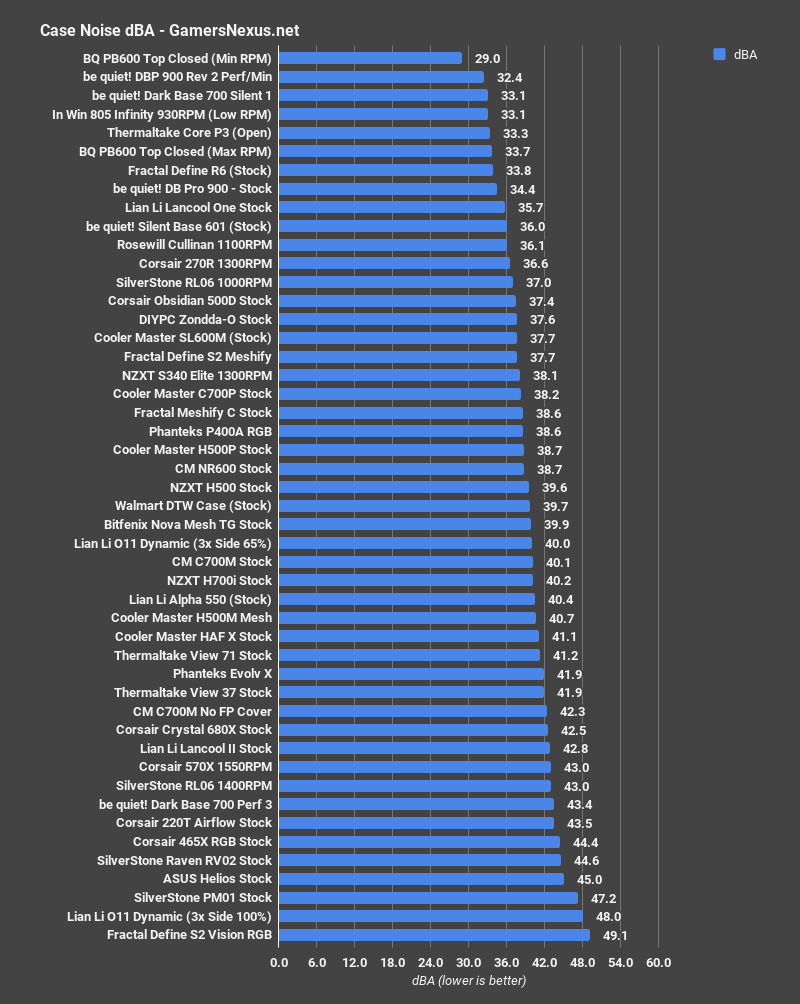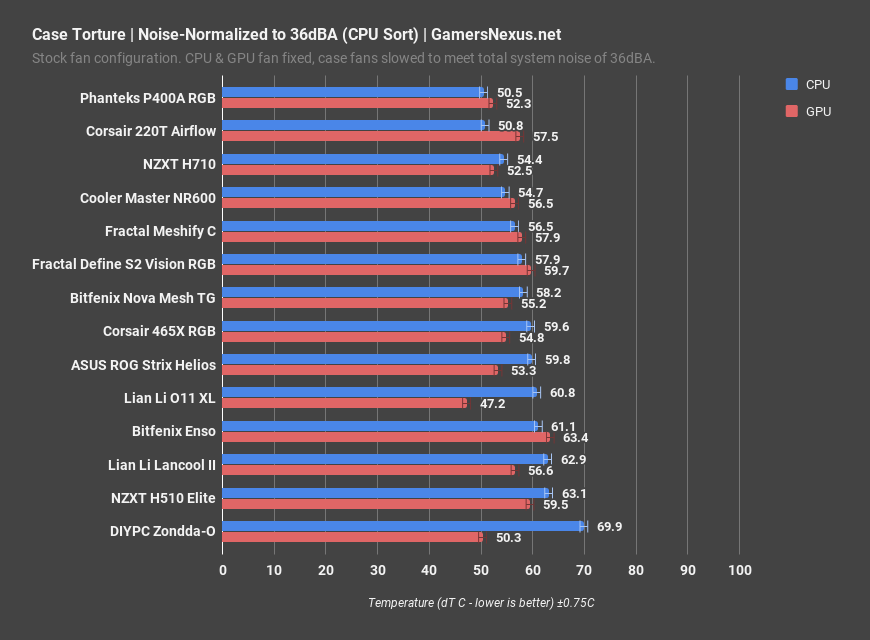In the proud tradition of the Phanteks P400A, the Lian Li PC-O11 Air, and the entire Cooler Master HAF family, the Corsair iCUE 220T RGB Airflow is another case that has the bravado to put “airflow” right in the name. As we’ve seen in the past, though, sometimes a name is just a name, and it’s our job to put that to the test. The original H500P was an example of this, and it tucked its tail between its legs and released a fix later. The 220T comes in black and white and in two variants, “airflow” and “tempered glass,” of which we’ve received the former for review. The tempered glass version is $10 more and has a glass front panel rather than a steel one. We’re more interested in this one, clearly, and so we’ll be reviewing the 220T Airflow today.
Corsair 220T Airflow Case Specs
Case Dimensions | 395mm x 210mm x 450mm |
Maximum GPU Length | 300mm |
Maximum PSU Length | 180mm |
Maximum CPU Cooler Height | 160mm |
Case Expansion Slots | 7 |
Case Drive Bays | (x2) 3.5in (x2) 2.5in |
Case Form Factor | Mid-Tower |
Case Windowed | Tempered Glass |
Case Warranty | Two years |
iCUE enabled | Yes |
Case Material | Steel, Tempered Glass |
Radiator Compatibility | 120mm, 140mm, 240mm, 280mm, 360mm |
Case Power Supply | ATX (not included) |
Weight | 6.5kg / 14.33 lbs |
Lighting | RGB |
Case Drive Bays 3.5" | 2 |
Case Drive Bays 2.5" | 2 |
Price | $100 |
The Build & Build Quality
The front panel is the distinguishing feature between the two main variants of the 220T, and it was the focus of our attention in this review, for that and a couple other reasons. We can start with one point that’s typically low on our list of priorities and minimized in our reviews: aesthetics. We think the front panel is ugly. That’s a matter of opinion, of course, but we just don’t like the asymmetrical patterning and the way it breaks up the outlines of the RGB front fans. It looks almost as if the pattern wasn’t test-fit properly, because there are a few somewhat random-seeming gaps in the repeating design where it just wouldn’t fit, breaking the repetition of the tiling and leaving instead a solid piece of steel. This doesn’t seem intentional, but rather like the design was customized to a different panel size. Corsair has gone out of its way to make a front filter without the typical reinforcing bars that get in the way of RGB fans on other cases, and that works perfectly well with glass, but it’s wasted behind the patterned steel of the airflow model. The nature of the weird lightning-cloud-ish pattern means that there’s much less ventilation at the bottom of the panel than the top, which has obvious airflow implications for the GPU, but also means that the ring of LEDs on the bottom fan is much less visible. It was possible to make an airflow version of this case that looks as good as the glass one. In fact, just removing the steel panel completely would look pretty good if it didn’t leave open holes in the front of the frame. Corsair did fairly well matching the color and appearance of the metal front panel to the plastic frame surrounding it (at least on the black model we received), but there’s still a clear difference in materials under bright lighting.
We already touched on ventilation briefly, but that’s the more serious issue we have with this design. It’s certainly better than a pane of glass, but it seems odd to specifically name a variant of the case “airflow” without leaning into it fully. It’s asking for scrutiny because it’s marketed that way. There’s already another version of the case for people who don’t care about cooling, this should be the one where Corsair adds another fan or has a wide-open front panel or somehow takes a real stab at making this an airflow case. Instead, there’s a moderately-ventilated steel panel that does have some gaps around the edges to let air in, but prioritizes decoration over function.
Removing and replacing the panel is perhaps its strongest positive point. The front panel is made of two pieces: a plastic frame around the outside that’s intended to be permanently attached to the chassis, and a protective steel rectangle that snaps into the frame over the front filter. There are four snaps, they’re easy to undo, and accessing the front filter is effortless. That’s really all there is to say about it; we wish it were always this easy, and Corsair did a great job on its mechanical execution of the panel attachment. Corsair could have gotten bonus points here by having a removable fan/radiator mount as well, but sadly, all fan slots are cut directly into the chassis. Removing the filter itself is equally easy, but we did notice that one of the small magnets that holds it in place had worked itself free and remained stuck to the steel of the case. As we mentioned earlier, the front filter lacks reinforcement. This hasn’t caused any issues so far, but the fact that every single other plastic-framed filter that we can remember has had some reinforcement makes us wonder whether this one will sag inwards towards the fans over time. The upside is that no reinforcement does cut down on plastic obstructions to intake.
The 220T’s dimensions appear normal from the front, but its depth is similar to the sawed-off form factor of Fractal’s Define C, which will only become more common as case manufacturers begin to eliminate the space that was once occupied by stacks of hard drives and optical drives. We’re generally in favor of the smaller case footprint afforded by eliminated bulky drive bays (at least, as long as there are other case options on the market for those who want several HDDs); however, the space under the power supply shroud is one area where smaller cases are notably worse. Corsair has managed to fit a two-slot HDD cage under the shroud, but space is at an absolute premium--our run-of-the-mill 16cm power supply barely fit with the cage in the default position. The cage can be adjusted forward for more room (or backwards to fit a radiator), but only if the lowest front intake fan is removed. Corsair deserves some credit for making the best of a bad situation by making the HDD cage both adjustable and removable, but buyers should measure their PSUs carefully before committing to any case with these dimensions.
The LEDs in the three included case fans are controlled by a Corsair Lighting Node CORE. The positives are that it uses a USB 2.0 header and is therefore almost universally compatible with motherboards, it has a built-in rainbow pattern even without software control, and it has three unused plugs available for connecting more Corsair fans or case lighting. Corsair uses separate headers for RGB and fan control, so the fans still use standard 3-pin plugs, which is the method we prefer. The downsides are that the CORE doesn’t take input from a button or from standard RGB headers, so it’s Corsair’s iCUE or nothing for controlling the color scheme. Corsair also uses their own style of RGB connector, so their own products are the only things that will easily connect to the CORE.
Corsair 220T Airflow Thermals
Moving into the thermal section, we can start with the upside that, no matter what, this is going to perform better than the glass-fronted version. Note that, for the standardized fan test, the 140mm front intake fans were pushed as far up as they could be, so there was less air being pushed under the GPU than with the three 120mm stock intake fans. This choice was made because the front design of the panel would make this one of the better configurations for our standardized setup. The three stock intake fans were 1400-1500RPM during stock case testing, with claimed RPM for this kit being 1400.
We stuck to our normal round of thermal tests for the most part, although we broke the “no front panel” test into two parts: one test without the steel panel and one test without either the steel panel or the filter behind it.
GN Case Testing Bench
| Component | Courtesy Of | |
| Video Card | MSI GTX 1080 Gaming X (OC Mode) | MSI |
| CPU | Intel i7-6700K @ 4.4GHz | GamersNexus |
| CPU Cooler | MSI Core Frozr L | MSI |
| Motherboard | MSI Z170A Gaming M7 | MSI |
| Memory | Corsair Vengeance LED 32GB 3200MHz | Corsair |
| SSD | Samsung 850 EVO 120GB | Samsung |
| PSU | Corsair RM650x | Corsair |
| Cables | CableMod Pro Mesh Cables | CableMod |
| Case | This is what we're testing! | - |
The video card is configured to run at 55% fan speed at all times.
Prior to load testing, we collect idle temperature results for ten minutes to determine the unloaded cooling performance of a case's fans and air channels. Thermal benchmarking is conducted for 1400 seconds (23 minutes), a period we've determined sufficient for achieving equilibrium. The over-time data is aggregated and will occasionally be compiled into charts, if interesting or relevant. The equilibrium performance is averaged to create the below charts.
Load testing is conducted using Prime95 LFFTs and Kombustor “FurMark” stress testing simultaneously. Testing is completely automated using in-house scripting, and executes with perfect accuracy on every run.
Corsair 220T Airflow CPU Torture
We’re starting with just the CPU torture thermals of the Corsair 220T Airflow in a few different configurations, then we’ll move to comparative benchmarks versus other cases. The CPU averaged 51 degrees Celsius delta T over ambient during torture testing, which dropped surprisingly little with the front steel sheet removed, down to 48 degrees Celsius. That’s 50.5 degrees versus 48.3 degrees over ambient, to be precise, so really barely more than two degrees of difference. Removing the filter as well to clear every obstacle in the path of the intake fans took the temperature down one notch further, with a resulting average of 45 degrees, but that’s still not as far from the baseline temperature as we’d see with most cases. That said, this is for CPU thermals, and the GPU is the more obstructed of the components given the large steel area for Corsair’s logo. Right off the bat, Corsair’s front panel design is proving to be less restrictive than it looks, although obviously the bare filter still performs better alone than with the decorative steel obstructing it. The gaps on the sides are a large part of this, as well as the relatively large size of the ventilation holes punched into the steel.
Here’s our truncated comparative chart. Even the baseline temperature is respectable compared to the rest of the cases on the chart. 51 degrees Celsius delta T is tied with the stock HAF X and the Meshify S2 for CPU temperatures, definitely towards the cooler side of the chart for the CPU. The 220T remains handily outperformed by cases that use a combination of good intake fans and a simple mesh front panel, like the H500M Mesh or the old RL06. The CPU dT of 48C that Corsair achieved with just the mesh filter and no panel is much closer to these higher-performing cases, tying it up with the P400A, one of our top-ranking cases of 2019. This is a well-cooled case for the CPU, but it could be a few points better with some design optimization. The Cooler Master H500 blank Mesh is also close by at 50 degrees, within error, and that’s one of the best budget cases for cooling on the charts.
Corsair 220T Airflow GPU Torture
GPU temperature was 53 degrees Celsius over ambient, which fell to 51 degrees delta T with the steel panel removed, and 50 degrees with the filter removed as well. Since the GPU in our test system has some ability to regulate its own temperature by adjusting clocks, unlike the overclocked CPU, deltas between test passes are potentially smaller--but this is still an impressively small difference. These results don’t mean that GPU temperatures are objectively good, but they do mean that Corsair’s front panel design isn’t significantly hurting performance, which was an initial concern.
Compared to the other cases we’ve tested, the GPU temperatures aren’t as impressive as the CPU ones were, but they’re still an acceptable range. 53 degrees ties it with the Evolv X and the Nova Mesh TG, both of which were cases that we had some problems with. The really exceptional airflow cases we’ve tested in the past like the RV02 and the HAF X fall in the 47-48C range, which is cooler than the 220T was even with the front panel and filter fully removed. GPU cooling would be better if there was no PSU shroud or HDD cage in the way at all, but with the case dimensions as they are, the shroud is necessary for holding loose cables. If we could make one major change to the case, it’d be to widen the chassis to allow for more cable management room, which would also allow eliminating the PSU shroud and perhaps making the 2.5” drive sleds behind the motherboard tray large enough to fit 3.5” drives, making the HDD cage less necessary. Then there’d be a straight shot from the bottom intake fan to the GPU cooler. It’d be a little easier to stick “airflow” in the name of a case like that, but even as it is, the 220T Airflow must be better cooled than the glass-fronted version. As for the P400A competitor, that’s at about 49 degrees over ambient, or about 4 degrees better than the 220T. The Cooler Master H500 Blank Mesh runs at 48.5 degrees, towards the top of the chart and objectively superior to the 220T.
3DMark
3DMark’s Firestrike Extreme stress test running on loop had a nearly identical result to the torture test, averaging 54 degrees GPU dT. That keeps it in roughly the same spot in the middle of the chart, still just on par with the Nova Mesh TG. We expect to see the stack change slightly in this test versus the GPU torture test because the CPU isn’t under nearly as much load during 3DMark testing, and therefore isn’t generating as much heat to influence the results. The artistic design of the front panel, which has less ventilation at the bottom than the top, doesn’t help with the obstructions to GPU cooling. For other comparisons, the Phanteks P400A runs at 49 degrees, a significant improvement for a case at the same $100 price point. The Cooler Master H500 Blank Mesh -- not the H500M or H500P, but the H500 -- runs at 49 degrees, also in an advantageous position. The 220T doesn’t compete very well versus these more properly airflow-oriented cases, despite being overall OK.
Blender
The Blender CPU-only render averaged 37 degrees Celsius, tied with the high-performance P400A and H500M Mesh, but still beaten by a couple degrees by chart-toppers like the RL06 and RV02. Still, this backs up what the torture test showed: CPU temperatures are good. Even without an exhaust fan, the front intake fans push an unbroken wall of air through the top section of the case and into the CPU cooler, and exhaust is free to passively exit through the rear and top of the case.
The GPU accelerated render brought the GPU’s average dT up to 25C, a slightly more favorable result relative to the rest of the chart than with the 3DMark or Furmark torture tests. The dynamics of the Blender tests are different because the components aren’t stressed to the degree that they are by the torture workloads; the averages here indicate to us that the 220T should be able to keep pace with GPU cooling under moderate load. It’s still not at the level of cases that have direct GPU cooling, like the SL600M at 22C or the HAF X at 23C GPU dT, but hot air isn’t being completely trapped either.
Standardized Fans
The result with standardized fans should be an excellent measure of how the 220T’s front panel design stacks up to other cases without being influenced by the quality of the stock fans. Remember that standardized fan testing was a highly requested benchmark from users, but that we spent significant time explaining the many imperfections with this approach to testing. It’s useful, but only if you understand why. We have a previous video to explain all of these important caveats.
The 220T averaged 48C CPU dT in this test, which is very good indeed relative to the limited number of cases we’ve run this test in so far. The P400A and Meshify C at 44C dT and 47C dT average respectively are the only ones to outperform the 220T here, which makes sense, as they both have very open mesh-fronted designs. We pushed the two 140mm Noctua intake fans that we use for this test as far up on the front panel as they’d go, which put both of them above the level of the PSU shroud and provided optimal cooling to the CPU.
The downside of this configuration is that it provided even less air to the GPU than the stock setup, and the 220T’s new average GPU dT went up to 57C dT, just below the Enso and the H500 at the hottest end of the chart. We could have pushed the intake fans further down to better balance the cooling, but putting a fan at the bottom of the front panel where it would be partially obstructed by the PSU and HDD cage and the front panel is a waste.
Noise + Noise Normalized
The 220T has three 120mm fans mounted directly at the front of the case without any real noise dampening between them and the user, so we expected it to be noisy. With the case fans at 100% speed, we measured the noise level to be 43.5dBA, definitely among the noisier cases we’ve tested and at the same audible level as the RL06. The fans included with the case are 1400RPM SP120 RGBs, and getting to the 36dBA threshold that we use for noise-normalized testing required lowering them to 55% speed in BIOS, approximately 1000RPM in actual reported speed.
Surprisingly, lowering the fan speeds so drastically had relatively little effect on the CPU or GPU temperatures. The CPU in particular maintained the same dT within a degree that it did with the case fans at full speed, while the GPU increased from 53C dT up to 57C dT. Of those two metrics, the GPU already had less headroom, so this isn’t a complete victory--but the difference in temperature is still minor compared to the reduction in speed. The 220T will still cool very well with the case fans spinning at half of their top speed, as long as the GPU isn’t under too heavy a workload.
Conclusion: Corsair 220T Airflow vs. Phanteks P400A, H500
The 220T Airflow performed better than we expected. Naming a case “airflow” in a world where cases with more fans and more ventilation have existed for years still deserves a little eye rolling, but the 220T does in fact have better airflow than its front panel would suggest, and almost certainly better than its glass-fronted sibling. It could be better still if there weren’t a steel panel on the front of the case at all, obviously, but even our usual A/B testing with the front panel on/off showed a relatively small performance gap. GPU cooling is the area with the most room for improvement.
Pricing isn’t unreasonable for the $100 Airflow model. We make comparisons to Fractal’s Define C TG and Meshify C cases in many reviews, but in this instance especially the 220T is a direct and targeted competitor to Fractal’s design. In light of that, the 220T with three decent RGB 1400 RPM 120mm fans looks pretty good next to the Meshify C with two non-RGB 1300-ish RPM 120mm fans. The kit of three fans and Lighting Node CORE that’s built into the 220T currently costs $70 when purchased separately. We can’t give the 220T an unqualified recommendation because of our general distaste for bloatware and nonstandard RGB connections, but for anyone ready and willing to embrace Corsair’s iCUE ecosystem, the 220T is a bargain. For everyone else, we still consider the P400A a strong alternative, but the 220T does serve a specific niche with its compact form factor.
If you want alternatives, the best to consider would be the Phanteks P400A (airflow) and Cooler Master H500 blank with the Mesh attachment.
Editorial, Testing: Patrick Lathan
Host, Test Lead: Steve Burke
Video: Keegan Gallick, Josh Svoboda, Andrew Coleman
